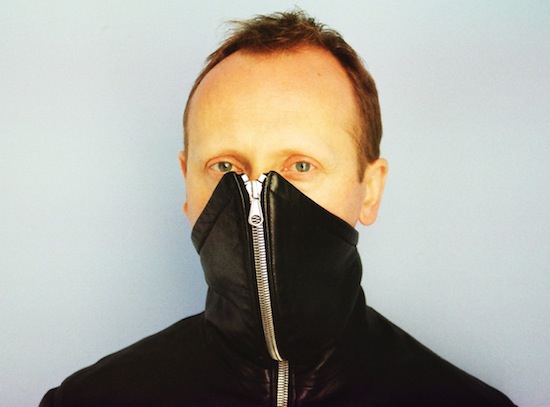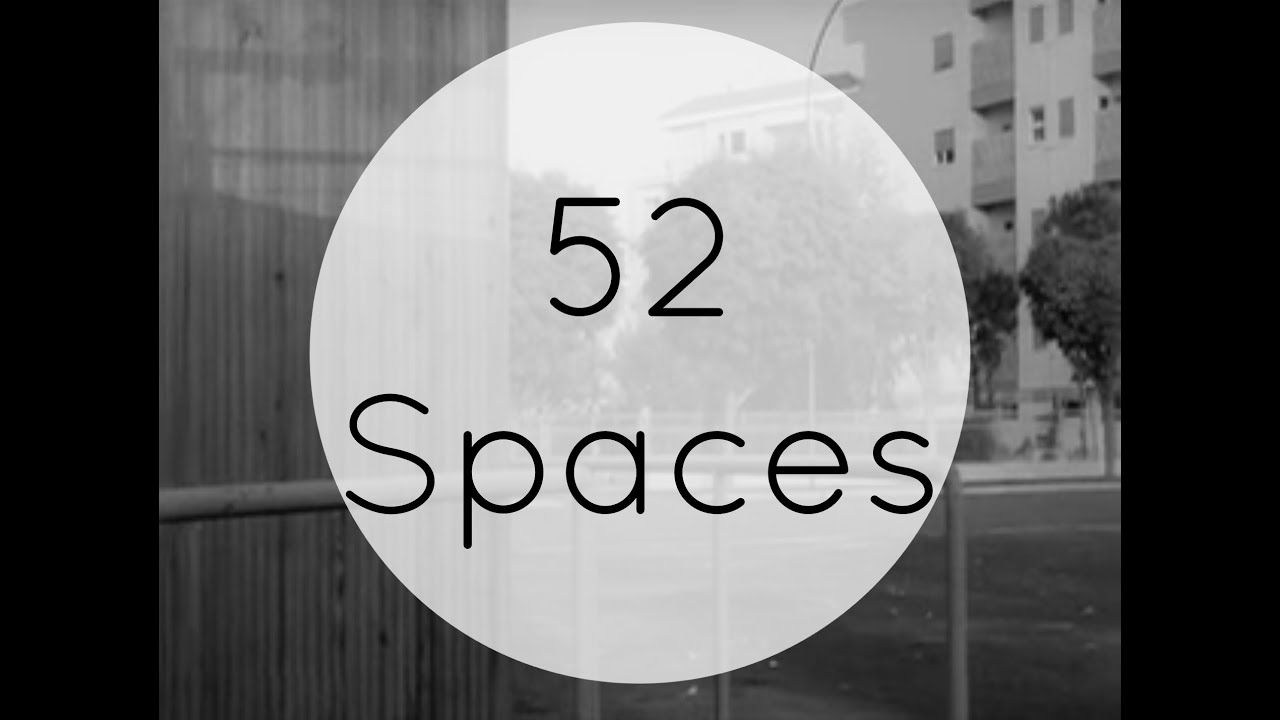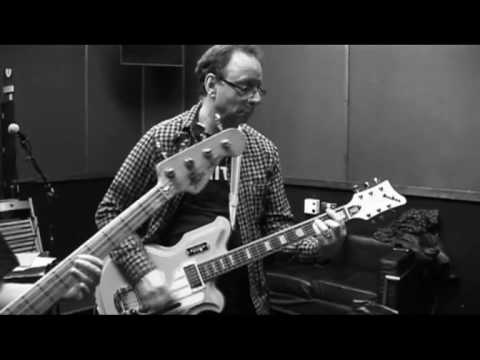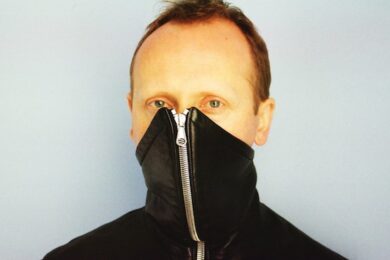1986: Various Artists: Peyrere cassette
Cassette compilation, first publicly available Scanner material
This is the first commercially available release I had. I made this collage booklet, and the tape features Band Of Holy Joy, Roland S Howard, Nurse With Wound, Total – which was Richard Heslop, a filmmaker who worked with 23 Skidoo – Test Department, Derek Jarman, Current 93, Pure and Coil. To get in contact back then was all via letters and meeting people, there was a different timeframe to the project because you had to wait for post and people. I still have the letters that I received back from these people, so there’s something quite magical about it. It was how I met Coil – I’d never sent them a copy, and Geff [Rushton] rang my mum to complain – my address was on the back. My mum said ‘there’s a man on the phone complaining that you never sent the tape’, but in a moment he calmed down and we were friends since. Nobody really knew who most of these people were. Test Department had probably released a couple of cassettes, Coil it was very early on in their days, Derek Jarman was a filmmaker that most people in music weren’t familiar with, so it was a case of taking ideas, putting them in this package, sharing them out and trying to make them into something more accessible. We sold about 400 copies, which at the time made me feel like a pop star.
1993: Scanner – Scanner
First album, made of telephone conversations recorded on a police scanner and accompanied by ambient musical textures
I’d be recording constantly, you couldn’t wait until you heard something interesting. The scanner was connected directly into a tape deck the whole time. This was ’91, ’92, this was anticipating an idea of the internet, there was no access to this kind of networked world that we’re so comfortable with today. These voices and accessing them suddenly took you into a very private place that you could never otherwise be in. Those ideas of public and private place are still things that people consider today. I remember Sleazy told me that the first Scanner album was the first record he had listened to from start to finish in years. Until you’ve actually engaged in the process of listening in to people’s conversations to this extent, you can’t actually understand how it feels to enter this particular sonic space. It’s one thing to listen, to be a voyeur to a recording, but it’s another to be absolutely inside the moment as it happens. It’s an extraordinary friction and tension. You’d be scanning through the airwaves and suddenly come across this conversation, and there was this electric thrill about it.
I realise now that electronic experimental music was either instrumental, or using lyrics. What I did was essentially make instrumental music with found lyrics, so rather than me trying to torture myself trying to write a lyric, I just allowed these really banal conversations to take the focus through. They would play my records in chillout rooms. I was supporting Orbital at a club on Chancery Lane, and this guy came up to me completely wasted with his finger hovering, pointing, he said ‘you’re …. er ….’ Scanner. He said ‘yeah… your music fucks me up’.
1997: The Garden Is Full Of Metal
Derek Jarman tribute record
I met Derek Jarman at the ICA around the Peyrere tape. I’m not very intimidated by an idea of fame, so if I see someone and think I can talk to them I will, so I went up to him at the ICA and he was the friendliest man imaginable. I was familiar with his films, particularly his connection with Throbbing Gristle, and we became friends. I used to go to the Diorama at Regent’s Park where Jarman would show sketches of his films, Michael Nyman would play piano pieces, absolutely fantastic on a Sunday afternoon.
When I played at the Air Gallery I asked Jarman to film it, and he said yes but didn’t turn up. I was a bit disappointed, but when I got home my mum said ‘oh, a man called Derek called for you, and said he was too busy working on Caravaggio so he couldn’t come and film’, and I thought that was lovely of him. Then about a month before he died I sent him a packet of sweets, and he sent this postcard… he was pretty much blind, and in a terrible scrawl it said ‘thank you so much, they’re my favourite sweets’. A little while later I got the call saying that he’d died. I was walking through St James’ Park on the way to the ICA that night, and I remember crying all the way, coming to terms with the fact that this was the place I met him, and the place would be haunted by his memory.
Such an inspiring character, and one of those people who if they were around today would have embraced using miniature technologies like the iPhone, using online availability of technology and sharing material. Jarman’s practice was completely collaborative. I made a couple of pieces for his films at the time, and The Garden Is Full Of Metal is a reference to where he used to live in Dungeness. He championed the land, as his life was ebbing away, he was able to bring life to the stony ground next to a power station.
The CD features recordings of his voice that I made over the years, and I collaged those together with pieces of music I wrote and recordings of where he used to live, so the walk from his flat in London to one of his favourite restaurants, the walk from his house in Dungeness to the seafront, so I recorded the steps he made to engage with the world around him. It’s the only album in my entire discography recorded under my own name, rather than Scanner. He was an important artist for a whole generation of people, and I’m struck by how he’s pretty much invisible now. This was a celebration of someone who meant a lot to me personally, and a figure in British creative culture at that time.
2001: Collaboration with Mike Kelley – Esprits de Paris
Collaboration at the Pompidou Centre, Paris
This an extension of the first releases, which were voices, and this is about ghosts. I was working in Rotterdam on a project called I Rip You You Rip Me, and met Mike there, and we remained in touch. The Pompidou wanted an exhibition on how sound worked, and Mike and I agreed something very simple – we were interested in ideas of ghosts and haunted places. We recorded in a dozen locations in Paris – Tristan Tzara’s grave, Edith Piaf’s grave, the apartment where Jim Morrison died, outside Serge Gainsbourg’s house. We left the lens cap on the camera, because that’s how you record ghosts basically, they imprint themselves on the video tape. We had Lars Von Trier’s cameraman and this whole crew set up in Paris with the lens cap on, and they’d look at me and Mike and think ‘who the hell are you and what are you doing?’. We took these audio and visual recordings to the Pompidou and called it Esprits De Paris, which I still think sounds like a perfume. We had 12 video screens, and another video screen of a disco in Paris through a heat sensitive camera, so what you could watch through the installation was bodies warming up as they dance.
Mike and I stayed in touch and in 2011, not long before he died, we were putting together plans for actually recreating it and making another version. We filmed a medium at the time, and watched the temperature in her body change, in her head and hands. Mike was a super bright intelligent guy who made some inspirational works, and to this day it pisses me off that he killed himself. One can’t harbour those kind of feelings, it’s not healthy, but there was so much more that he had to do. He was somebody who had many problems, particularly with the system that you have to work in in a gallery. In music there’s an independence about it that you can embrace. In visual arts you sign with a gallery, and then you’re pushed into a particular direction that it’s very tricky to move away from. He had a lot of issues with that world, and I remember going to dinner with him about 18 months ago after a gallery opening and him just looking around and saying, "who are these people, who the fuck are these people?"
1997: ‘My Lost Love Hunting Your Lost Face’
Track taken from the album Delivery
I never talk about tracks that mean something to me. I wasn’t sure what to choose… this was recorded when I moved here, where we’re sat right now. The rhythm is made from something I recorded on the radio and then filtered through a sampler, then strings and trumpets, it’s quite emotional. This space, when I moved here, it was an old soap factory, and it was very resonant – I didn’t use any reverb because I was hearing it all the time. I’d just broken up from a long term relationship, and I don’t write confessional songs, but the title is a line from a poem by Robert Lowell, who along with people like Sylvia Plath developed a type of confessional poetry. Lowell was famous for doing things like using lines that people had said to him that day, or letters he’d received, and putting them directly into his poems. As I was taking these words that I had found and throwing them into the music, I always felt there was a relationship with his poetry and my work, and I always loved that phrase. It was the time that we all reach in life where you hit an absolute low ebb. My work generally isn’t exploring those emotions, but I felt it was important to demonstrate a vulnerability, you aren’t a metal-plated Robocop. This was written very quickly at a time of great darkness, but it has a great emotional resonance.
2002: 52 Spaces
Response to Antonioni’s L’elcisse; CD, installation, project
It’s a fun one. I was invited to a modest residency at the British School in Rome, you go in, you make a work and leave. I saw a film called L’eclisse – The Eclipse. I thought it was really interesting because it was made 40 years to the year before I was there. I was looking at Rome 40 years before, so it was a bit of time travel. Like many of his films it goes very slowly, and they’re often about broken and destructive relationships. At the end of the film the two characters arrange to meet, and the camera awaits their arrival in 52 different locations. So I took these 52 sections that take about two minutes and slowed them down so it takes 45 minutes. It moves incredibly slowly, and then I re-soundtracked it using sounds from the films, voices, bicycle bells, conversations, taxi tyres, footsteps, and wrote another piece of music around it. It’s a very slow-motion piece. It demands something of the audience, it was a reaction against the very fast graphics that everyone was using for gigs at the time, these super fast high-energy techno videos. I thought let’s make something that’s incredibly slow, black and white, and they’re going to fall asleep to it. It’s really interesting to see the responses, some people say ‘I loved it, I kept my eyes shut all the way through’, some people fall asleep, it doesn’t bother me. It was meant as a graceful slowing down of the mind.
2003: Salles Des Départs
Raymond Poincare Hospital – Garches, France
This is the soundtrack to a working morgue in a hospital. I received an email that said ‘Dear Scanner, would you be interested in considering this proposal? We have a hospital in Garches on the outskirts of Paris that this guy called Ettore Spalletti has designed. Would you consider coming to visit and designing the sound for it?’ The building is beautiful, and the morgue is the place where you spend your last 15 minutes with a loved one. The hospital specialises in accident victims, so it’s not like you’ve had an opportunity to say farewell, it’s somebody you were sleeping with the night before, your partner, one of your family, your child, or a friend. So you’re there spending 15 minutes with this person who no longer exists.
The space is a liquid blue. It was an almost impossible commission, and I actually wrote and said ‘I don’t think I can do this’. But I was sat here, and it started to pour with rain outside, and I thought it’s so comforting being indoors and hearing the rain beat against the window. I started to record that, and other sounds, birdsongs, whispers, and I recorded this piece of piano music and processed it so it appears far away, then it disappears… I thought you can’t write a requiem, people are going to be heartbroken as it is. This is about presence, it’s about offering another texture and presence to the space. I never told them that my father had died in a motorcycle accident, so my family had to go and identify a body in a hospital in a very similar way when I was a teenager. I could understand how this would feel, this element of shock. It’s a place of solace and a place to say goodbye to a loved one. Out of all my projects this is probably the most responsible one, and the one where I’m most invisible, in a way.
2004: Qualia
Collaboration with choreographer Wayne McGregor at the Royal Ballet
My work has been associated with dance since I began. Very early on, people started using my music with dance. I realised it’s because it’s very abstract at times, it’s very textural, and it doesn’t necessarily tell a story so it can be adopted and adapted in many different ways. I’ve worked most consistently with Wayne McGregor, who recently did the Atoms For Piece video and worked with Thom Yorke. Wayne and I have done about 12 pieces together, and Qualia was the one I wanted to talk about. It was a commission by the Royal Opera House in 2004, and Wayne had only just entered those auspices, it was quite an intimidating place. He said ‘let’s really scare them’, so he made these outfits that were skin-tight shorts and skirts and made of really reflective white material. The lights that shone onto these were so bright that you couldn’t see the motion of the bodies, they were liquid light, it was incredible. He said ‘let’s really push it with the sound, and it goes through a whole series of moods’. I played it live, and they had this little cross drawn from me on the floor so I could stand there, look up at the audience, and wait for my cue on headphones. The first thing I saw when I looked straight ahead was a blue rinse lady looking at me absolutely terrified, as if she was in a wind tunnel. It was very, very loud, the review in the Daily Mail reviewed the dance, absolutely hated it, then there was a full stop and it said ‘And by the way, the music was rubbish’.
2004 to present: Githead
Guitarist in a band with Wire’s Colin Newman, Malka Spigel and Max Franken
Githead came about in a playful way. I’ve known Colin [Newman] and Malka [Spigel] for years because they live in the same area as my parents, and their son went to the same primary school as I went to. They had this record label, swim~ and wanted to put something together for the anniversary. Colin said ‘do you want to do something?’ I felt that I wanted to play the guitar, and I went round and within about 20 minutes we’d written about three songs. It was so fluid, there was no stopping us, it really was an incredible fresh-smelling diarrhea. The biggest problem was trying to find a name for the band, and we had all kinds of pretentious names, and then in the studio one day we had some kind of modest argument and I said to Colin, ‘you’re such a stupid githead’. We laughed so hard, as it was such a stupid word, and we agreed it had to be the name of the band. For me, Githead is my little holiday, I can play in a band, play with friends, play guitar loud, which I love to do. It’s great working with a married couple, because whenever I make mistakes Colin blames Malka or Malka blames Colin, so I get away with a lot. We have really good fun, that’s really important. It’s great to talk about these very immersive projects, but one mustn’t forget the joy, and in Githead it’s joyful, it’s meant to be fun.2012: Sprint
Collaboration with United Visual Artists for US telecoms advert
Sprint Dream Male from Scanner on Vimeo.
I was given the chance to make something that was completely mine that goes out to 2.5 billion people and is in 70% of cinemas in America. I was working with a group called United Visual Artists, who historically have visualised shows for people like Massive Attack and U2 and do extraordinary, dynamic visual representations. We made an installation for Creators Project, and then after that they came to me and said ‘we’ve got this mad opportunity’. It’s meant to be what a phone remembers during the day, so we had a shower, the subway, and over the period of a month, as they worked on the video, I tuned the soundtrack to the ad. The piece was made in this real set, we had to kick Coldplay out of the set so we could use it. I’ve also been working with this Swiss design company called Punkt, making alarm clocks and phone tones, and it’s great because these products go out into the world, and your sound is out there, changing peoples’ private environment.
2013: Spitalfields Festival
They came to me and asked if I would be interested in being their Associate Artist. It basically means you come in, find a theme and invite other artists in. I invited Elizabeth – Gazelle Twin – and Bobby – Haxan Cloak – to make projects for it. I thought these are artists I really expect and admire, and how can I support them, because in my career people have been supportive as well. I approached them with the idea of looking at a piece of music written nearly 500 years ago by a British composer called John Dowland, called Lachrimae, and it’s almost like the earliest version of systems music, not unlike Steve Reich, Philip Glass. What Bobby and Elizabeth are doing is both taking these ideas and building it into their own processes. Bobby is making his own set completely inspired by these works with a film and a live drummer. I’m doing my own variation with a specially commissioned film, which is going to be very dark and very gothic. Elizabeth is taking four locations, and has the Elysian Quartet at one of them, a choir at another one, and you travel between locations and hear this piece of music at each one. They’re all unknown locations, mostly underground, in Spitalfields. It’s going to be a quite unsettling work.
Scanner collaborates with Gazelle Twin at Drill:London the Wire and Quietus curated festival that takes place next week. They play Cafe Oto alongside Land Observations and Klara Lewis on Friday, March 22nd. For tickets, go here





